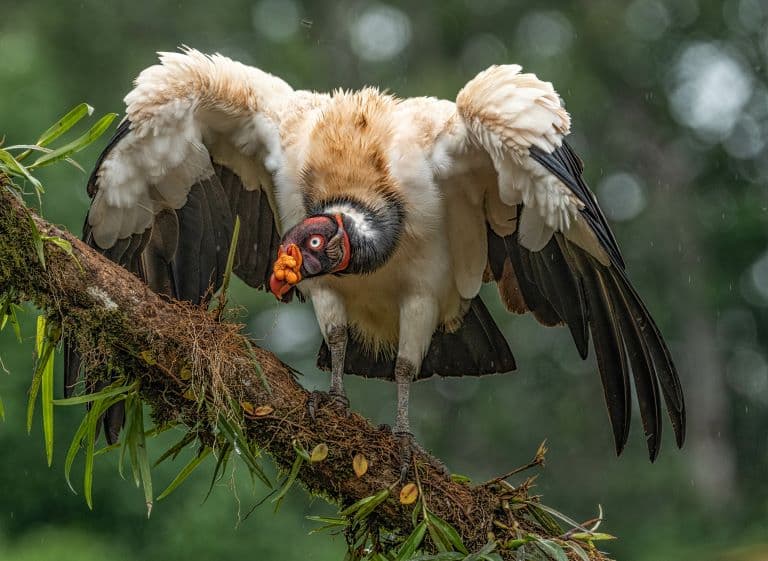King Vulture Profile
Back before the era of easy-access photo manipulation, there was a golden age of exploration where people could go out to a strange place, take photos of strange animals and bring them back to their strange friends with proof that these animals did, in fact, exist.
But before that, people would have to make drawings, and since drawings are proof of absolutely nothing, William Bartram’s “Painted Vulture” description from 1770s Florida wasn’t taken seriously by everyone.
But such a colourful and bizarre-looking vulture does exist and is just as strange as Bartram’s description. Now known as the King vulture, it’s the only one of its kind.

King Vulture Facts Overview
| Habitat: | Grassland, savanna, forest |
| Location: | Central and South America: Southern Mexico to Northern Argentina |
| Lifespan: | 30 Years in captivity |
| Size: | 81cm (32 in) long, 2m (7ft) wingspan |
| Weight: | 4.5 kg (10 lb) |
| Colour: | White beneath, with black wings and tail, grey shoulders, brightly coloured red/black/yellow faces |
| Diet: | Carrion, sometimes live prey, fruit |
| Predators: | Snakes, jaguars |
| Top Speed: | Unknown |
| No. of Species: | 1 |
| Conservation Status: | Least Concern (IUCN) |
King vultures are so named because of the exceptional ornaments they wear on their heads. But they also have a regal attitude and don’t take lightly to having to share a meal with the serfs.
They’re one of the strongest birds around, so have few predators and dominate most settings.
They have been revered by local cultures since human settlement, and this shows up in the written record of the Mayans, who deified the species.
Interesting King Vulture Facts
1. They’re the only ones left
King vultures have earned their crowns by being the only remaining vultures in the genus Sarcoramphus. This genus once had a wide distribution that covered the American Northwest and likely farther afield, but the fossil record is patchy and inconclusive.
Peru appears to have once supported a species, as, it was once thought, did Cuba, but remains from the latter country had been misidentified. What we do know, is that the single remaining species is a large, tenacious bird with a lot of flair.
2. They’re big
At first glance, the title of “Third-largest New World vulture” sounds like as much of an accolade as being “New Zealand’s fourth-most popular folk parody duo”, but despite all the qualifiers, this is clearly a big animal.
King vultures stand almost a meter tall and have twice that in wingspan, with broad wings. But what really sets them apart is their accessories. Their irises are bright white and their beaks are the most robust of any New World species.
And with large size, come large caruncles. 1

3. Fleshy Caruncles
As we all know, this is the title of the under-rated predecessor to the cult classic Fleshy Caruncles 2 and a work that really set the pace for the ensuing Fleshy Caruncles 3 to 9.
But before these epics, it was also used to refer to a wobbly appendage seen on some birds. Also known as a wattle, this is most familiar to us from cocks, who sport a big one on the top of their heads, and turkeys, who seem to have far too many of them in general.
These are essentially wobbly appendages used specifically to flap at females for attention, but we don’t recommend this as a courtship ritual in humans; human appendages just don’t have the same effect.
The King vulture has some truly glorious caruncles, contrasted on its face against black, velvety feathers and the bright, piercing eyes. 2

4. (Nearly) everyone cedes their position to the King
The King vulture’s eyes aren’t just for show, they also have excellent vision and will find carcasses by sight.
These big birds are dominant in their communities and will chase other species off a carcass to get to it. American black vultures have to stand aside, and the King has no natural predators other than egg-eating snakes and the occasional jaguar, in regions where their territories overlap.
They’ll fight amongst themselves, too, and have a dominance hierarchy like many other groups of birds.
The only animal tough enough to stand their ground in the presence of this bird is the Andean condor. 3
5. Adults will eat anything
Vultures are not known to be picky eaters, and the King vulture doesn’t defy convention in this regard. They’ll eat cow carcasses, monkey meat, beached fish and rotting lizards.
Some have adapted to eat domestic livestock, though they don’t generally kill them. They have been known to take live animals, but prefer carrion to fresh meat.
Since they don’t have a strong sense of smell, they are thought to follow other species to their food, and then take first pickings on account of them being huge and capable of throwing their weight around.
But having the strongest beak around, they service the smaller birds by tearing into tough carcasses and opening them up for the weaker-billed vultures to get into.

6. Their babies eat fingers
One breeding pair was studied to find out about the development of their young. From a single egg, a nestling was bred by the pair, and from the bones left in the nest, it appeared that the baby was fed primarily on fingers from young oxen. 4
7. They’re decreasing
Despite all the finger eating and carcass fighting, these are a species in decline and while they’re currently listed as of Least Concern by the IUCN, this might not be the case for long.
Habitat destruction is the key issue, as the bird requires substantial amounts of forest for nesting. Deforestation threatens more than other causes of decline such as trophy hunting, which remains a steady, but relatively lesser danger to the species.
8. The Mayans liked them
Pre-Colombian Maya books, known as codices, were written by the natives of the region on bark paper. These were supposedly written by highly educated scribes who were inspired by the gods of the forest.
King vultures were one of the most commonly represented birds among these codices, often portrayed as a god, in the form of a human body with the vulture’s head. They were said to carry messages to and from humans and the other gods. 5
King Vulture Fact-File Summary
Scientific Classification
| Kingdom: | Animalia |
| Phylum: | Chordata |
| Class: | Aves |
| Order: | Accipitriformes |
| Family: | Cathartidae |
| Genus: | Sarcoramphus |
| Species: | Papa |
Fact Sources & References
- HARVEY I. FISHER (1944), “THE SKULLS OF THE CATHARTID VULTURES”, Museum of Vertebrate Zoology, Berkeley, California.
- “What is a Caruncle?”, Red Park Zoo.
- Arroyo-Arce (2018), “King Vulture (Sarcoramphus papa) scavenging at green turtle (Chelonia mydas) carcasses in Tortuguero National Park, Costa Rica”, Sci Hub.
- Eduardo Pio Mendes de Carvalho Filho (2004), “BREEDING BIOLOGY OF THE KING VULTURE (SARCORAMPHUS PAPA) IN SOUTHEASTERN BRAZIL”, – Research Center for Conservation of Neotropical Birds of Prey.
Odilon Braga. - Alfred Marston (2008), “Animal figures in the Maya codices”, Internet Archive.
